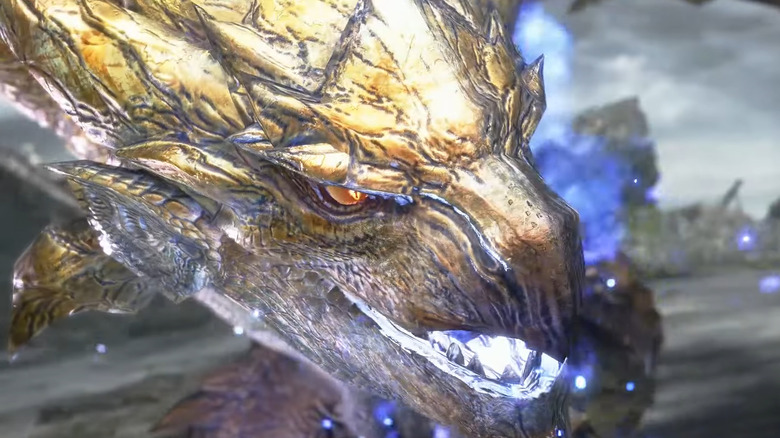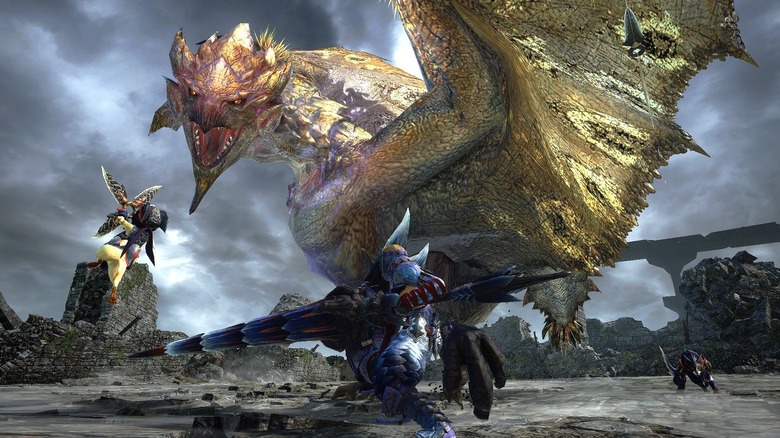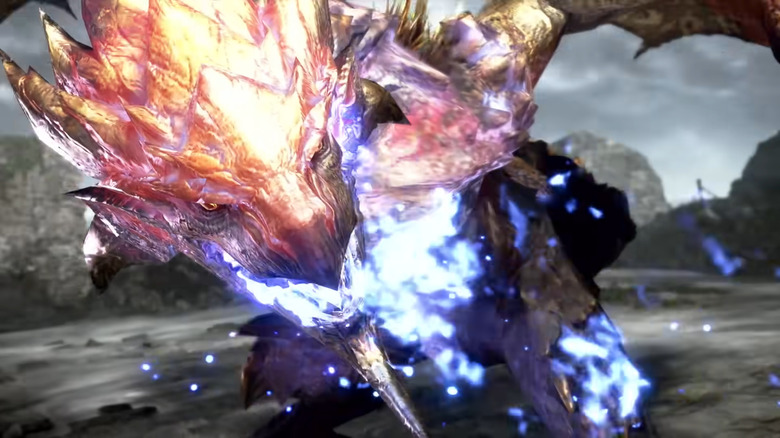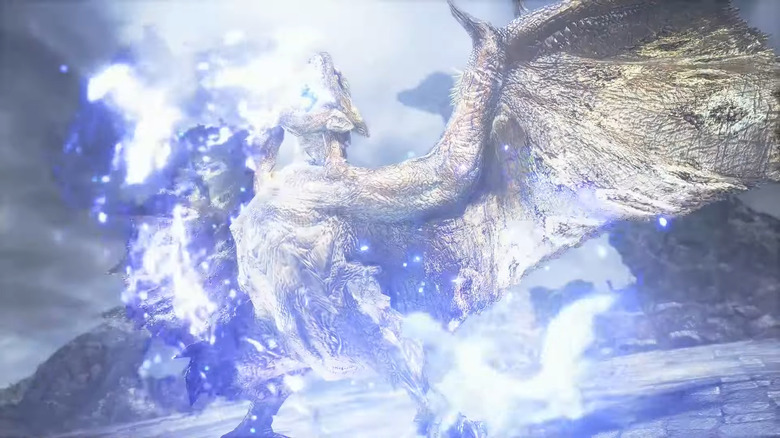Monster Hunter Rise Sunbreak: Gold Rathian Weaknesses Explained
"Monster Hunter" is well-known for its elaborate and involved mechanics that are on an entirely different level of complexity than most other games of its genre and caliber — and the most recent entry, "Monster Hunter: Rise," is no exception. The timed Nintendo Switch exclusive sports an intricate system of monster weaknesses and vulnerabilities corresponding to each damage and element type that also vary by the body part receiving the hit. And that's not even mentioning the ailments mechanics, which has five parameters each for all 10 ailments and status effects a player can inflict on a monster.
In short, being successful as one of the eponymous Monster Hunters in "Rise" requires a solid understanding of a target's weaknesses, and with each new monster added in every update comes a new set of variables to pick apart. With the release of the first expansion, "Sunbreak," the series veteran Gold Rathian will be joining the ranks of the new and classic monsters in "Rise" — here's a breakdown of this rare dragon's new weakness values in "Monster Hunter Rise: Sunbreak."
Physical damage weaknesses
"Monster Hunter Rise" features the same traditional damage and element types as seen in most of the franchise, with damage values being separated into physical and elemental categories that are then further sorted into distinct types. Physical damage — also known as "Raw" damage or "Attack Power" — has three categories of Severing, Blunt, and Projectile that determine effectiveness against certain body parts of specific monsters. Despite being a returning creature, the Gold Rathian in "Sunbreak" carries revamped weakness values that differ from its most recent incarnation in "Monster Hunter World: Iceborne." With higher numbers meaning increased vulnerabilities, the Gold Rathian's damage values are as follows (via Fextralife):
- Head: Severing 22 – Blunt 22 – Projectile 22
- Neck: 22-22-22
- Torso: 25-30-30
- Back: 22-22-15
- Wing: 35-35-35
- Leg: 44-44-45
- Tail: 20-20-45
- Tail Tip: 45-45-45
To summarize, it seems that the Gold Rathian's weaknesses aren't particularly skewed to any damage type, as vulnerabilities for all three are relatively even for each body type save for the tail having a high vulnerability to Projectile damage only. The head, neck, back, and tail are the least effective places to attack, the torso and wings form the middle ground of being neither incredibly defended nor particularly vulnerable — though the wings are weaker overall — and the most effective places to hit are the legs and the tail tip, which have high vulnerabilities across all three damage types.
Elemental damage weaknesses
Elemental damage is divided into Fire, Water, Thunder, Ice, and Dragon, and is calculated in tandem with the physical damage type of the weapon delivering the attack. In contrast to the Gold Rathian's largely revamped physical damage values, its elemental weaknesses remain more or less the same as they were in "Monster Hunter World." As such, the Gold Rathian remains completely immune to Fire and Dragon elements — with the small exception of its torso having a Fire vulnerability value of 5 — and those values have been excluded from the following list (via Fextralife):
- Head: Water 5 – Thunder 10 – Ice 5
- Neck: 5-10-5
- Torso: 10-15-10
- Back: 5-10-5
- Wing: 15-15-10
- Leg: 10-10-5
- Tail: 10-10-5
- Tail Tip: 10-10-5
Out of all the elements it is susceptible to, the Gold Rathian seems most resistant to Ice and most vulnerable to Thunder. To make the most out of its elemental vulnerabilities, players should aim Thunder damage against the torso and wings as well as Water damage against the wings. However, it's important to remember that elemental damage does not gain any Motion Value bonuses — damage multipliers based on combos — the way that physical damage does. Depending on your preferred playstyle and build, it may be wise to focus on Raw damage against the legs with a bonus of Water or Thunder damage instead of going after the wings or torso with an elementally-focused approach.
Status effect effectiveness
The way that "Rise" presents ailment weaknesses is slightly counter-intuitive: Despite parameters being labelled as "resistance" factors, more bars means less resistance. The stars beside the ailment's name can be a helpful at-a-glance guide, with more stars meaning higher vulnerability.
The five ailment vulnerability parameters are (via Fextralife):
- Initial Resistance: how many hits of an attack or item aspected to that status it takes to apply it for the first time
- Next Resistance Threshold: the size of the increments that a monster's resistance increases by with each successive application
- Maximum Resistance: the highest that a monster's resistance can reach regardless of repeated applications
- Natural Buildup Degradation: how fast status buildup degrades in between hits
- Total Damage, Damage, Effect Duration, or Stamina Loss: the strength of each ailment's actual effects
And the Gold Rathian's weaknesses — with a maximum of four bars per parameter — are as follows:
- Poison: Initial Resistance 0 – Next Resistance Threshold 0 – Maximum Resistance 0 – Natural Buildup Degradation 2 – Effectiveness 1
- Stun: 0-1-0-2-2
- Paralysis*: 2-1-1-2-2
- Sleep*: 2-2-1-2-3
- Blast: 0-1-1-2-2
- Exhaust*: 2-2-2-2-2
- Fireblight*: 2-2-2-2-2
- Waterblight*: 2-2-2-2-2
- Thunderblight**: 2-2-2-2-3
- Iceblight*: 2-2-2-2-2
As the maximum vulnerability stars a monster can have is three, the Gold Rathian seems to have a high resistance to status effects overall. However, if you have any elemental blight Exploit skills, going for any of the blights might prove fairly useful, as will taking advantage of the monster's lowered defenses while inflicted with Sleep.




